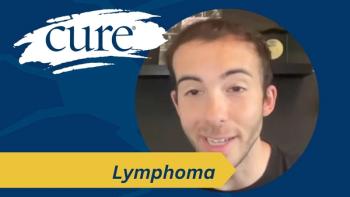
- CURE® Fall 2021
Pregnancy During Cancer: Treating Two Patients, Not One

Oncologists are learning that cancer can be treated during pregnancy with relative safety in the second and third trimester.
Progress has been made over the past few decades for women who are diagnosed with cancer while pregnant, leading to improved outcomes for both mother and baby. Cancer during pregnancy, however, is still a very difficult journey to navigate.
Much of the progress in this area has been made with the help of long-term observational research studies like the Cancer and Pregnancy Registry, which has been collecting information about the diagnosis and treatment of cancer in pregnant women since 1997.
“Now, after so many years of collecting information on many patients and their children, publishing and lecturing about such follow-up, the recommendation for (pregnancy) termination is less, which is good,” said Dr. Elyce H. Cardonick, director of the Cancer and Pregnancy Registry and a maternal-fetal medicine specialist at Cooper University Health Care in Camden, New Jersey, in an interview with CURE ®. “Oncologists are realizing that cancer can be treated during pregnancy with relative safety in (the) second and third trimester.”
PUTTING THE BALL IN ONE’S COURT
Stacey Jamerson, a 36-year-old first-grade teacher from Mansfield, Massachusetts, received a diagnosis of stage 3 alveolar rhabdomyosarcoma — an extremely rare, aggressive cancer more commonly diagnosed in childhood or adolescence — while she was pregnant with her fifth child.
After receiving a cancer diagnosis, pregnant women are given three options: terminate the pregnancy, deliver the baby preterm (before completing 37 weeks of pregnancy) so cancer treatment can begin (increasing the risk for the fetus), or allow the pregnancy to go full term and then provide treatment afterward (increasing the risk for mom).
A few weeks after diagnosis, Jamerson met with her doctor at Dana-Farber Cancer Institute in Boston and, to her surprise, set up a treatment plan and underwent chemotherapy.
“I was about 17 weeks pregnant, I think, when I met with my doctor the first time,” Jamerson said. “I Googled a little bit, but I didn’t Google a lot, so I just assumed you couldn’t have chemotherapy while you’re pregnant. It just didn’t seem to me like it was even a possibility. So I went into that first appointment assuming that it was going to be kind of a ‘We’re going to schedule the termination, and then we’ll go from there.’ But immediately, my doctor at Dana-Farber ... set up an appointment that same day with a high-risk (obstetrician) who ... was familiar with chemotherapy in pregnancy.”
Jamerson added that the specialized obstetrician discussed the different chemotherapy options available and worked with her oncologist to recommend a treatment that would be safe for both the mother and fetus while keeping Jamerson’s best interests in mind.
“Immediately (the obstetrician) put it in my court,” Jamerson noted. “They said some women don’t want to even consider being pregnant while going through chemo, and (they’d) support that. And some women need that bright spot of knowing that they have this baby that they’re working for, and if that’s what you choose, (they’d) support that as well. ... But all along, it was under the understanding that they had no idea how it would turn out.”
After Jamerson made her decision, her health care team constantly monitored her, not only because she was undergoing cancer treatment during pregnancy, but also because her pregnancy was already considered high risk; she previously gave birth preterm to two sets of twins. The monitoring included nonstress tests and ultrasounds, among other precautions.
ADJUSTING FOR BABY
Sara Diemer, a 37-year-old adjunct professor of art, youth director at her church and mother of two children (a 3-year- old daughter and 9-year-old stepdaughter) from Washington, Illinois, received a diagnosis of stage 4 inflammatory breast cancer while pregnant with her second biological child. She was also referred to a maternal-fetal specialist to help her through the treatment decision-making process.
“Being pregnant at the time was a big part of the conversation,” Diemer said. “But what controlled what we were going to do next was the fact that it was inflammatory breast cancer, which is an incredibly aggressive form of breast cancer.
We couldn’t even do necessarily all the normal staging with the best hopes of protecting our baby at the time, so we kind of piecemealed things together with
X-rays (and) wearing the heavy lead vests over my stomach area. We did different ultrasounds on specific organs in my body because I couldn’t go do an MRI.”
Those tests determined that Diemer had stage 4 cancer that had spread to many areas in her liver. A week later, she started chemotherapy, a treatment option that both her oncologist and her maternal-fetal specialist were on board with. After the second treatment, she had some spotting, and she immediately called her maternal-fetal medicine doctor, who asked that she come into the office right away. At that time, everything with Diemer and her baby looked good.
“There are a million reasons that (spotting) could be going on,” Diemer said. “(The doctors) were so good with sitting down (and) talking to me about everything. But at that point, we were still really, really hopeful that even though I was getting fairly beat up, the baby was OK.”
After Diemer’s third round of chemotherapy, she went home and noticed she was spotting again. She ended up going to the emergency department because it was late on a Friday night and she couldn’t get hold of her doctors.
“I was at 19 weeks at this point,” Diemer said. “If you were at 20 weeks, you’re automatically sent to (labor and delivery), and I was one day away from flipping to 20 weeks. I was like, ‘Just send me to (labor and delivery), just let me go up there.’”
She ended up sitting in the emergency department’s waiting area for hours, which she said was excruciating. Once Diemer was taken to a room, her first examination determined that everything still looked fine, but that changed during the ultrasound. Diemer didn’t think at the time to ask her husband to join her for the ultrasound, but now she wishes she had. “I regret it to this day,” she said.
During her ultrasound, Diemer noticed that her daughter was in a strange position.
“The tech was really looking around. I said, ‘You can’t hear a heartbeat, can you?’ She said, ‘I can’t tell you anything.’ ... I’m piecing it together myself fairly well at this time,” Diemer said. “(The tech) leaves the room to go get the doctor, and I have my phone. I texted my husband: ‘I don’t think there’s a heartbeat.’”
Once the doctor came in, he also tried to find a heartbeat. Diemer said she thinks it was difficult for him to deliver the news to her. A few minutes later, he said he couldn’t find the baby’s heartbeat.
“I was kind of in shock,” Diemer said. “I was kind of upset. I was kind of a lot of things at that point.”
Her husband then joined her in the room, during which the doctor gave the news to both of them. Once an obstetrician met with the couple, Diemer said she needed to confirm herself via a sonogram that, as the doctor told her, there was no heartbeat.
“We had named her. Her name was Leah,” Diemer said. “(When we looked at the sonogram), she was bent over backward. And I’m like, ‘I know that’s not a position that a baby’s in when they’re in the womb.’ And then there was just clearly no heartbeat. We listened for quite a while. And as absolutely crappy as that was, there’s that confirmation I needed so we could make that next step.”
AFTERMATH OF TREATMENT
Surgery can be performed at any gestational age, especially nonabdominal surgery, with relative safety for both mom and fetus. Radiation therapy is avoided, if possible, except for brain cancer. Although the effects of chemotherapy have not been studied in a large trial, researchers have observed its effects through case reports. These have shown that commonly used types of chemotherapy, like those used for breast cancer, leukemia and Hodgkin lymphoma, are often tolerated well by babies, whereas newer agents in development are relatively understudied in pregnancy.
“The placenta does its job of metabolizing the agents for the fetus,” Cardonick said. “If you wait a good three weeks after most chemotherapy agents until you deliver the fetus, then a couple things happen. The placenta has time to metabolize those drugs before the baby’s born, so we don’t have to rely on the baby’s liver to do it. And that’s why you want to avoid a preterm birth — because the baby’s preterm liver is not as good at metabolizing any drugs that are left in their system. Secondly, it allows for (the baby’s) blood count and mom’s blood count to come up.”
Cardonick added that researchers have compared the development of babies exposed to chemotherapy with those who have not been exposed, and there is no significant difference between the two groups; however, the difference is more pronounced when babies exposed to chemotherapy are born preterm.
Although doctors know more now about the potential effects of different treatments on a fetus, the prognosis is also based on how sick the mom is.
“If there’s widespread disease, think about how they have to maintain their own health and then support a pregnancy,” Cardonick said. “I don’t think that happens, honestly, in stage 1 and early cancers. ... There are reports of losses of babies more so in acute leukemia because the women can tend to be so sick, and it’s a bloodborne cancer as opposed to a solid cancer limited to the breast.”
Jamerson said she underwent treatments for about a year and is now cancer free. She said her pregnancy went smoothly during cancer treatment and through delivery. Her daughter is now 4 years old.
“She is amazing,” Jamerson said. “Medically, she’s been fine. She’s still followed by the cardiologists, who check her blood every now and then, but nothing has ever come up. She received speech therapy early on (for what) we thought was delayed speech, and she ended up graduating from that. This past December, she was diagnosed with (a mild case of ) cerebral palsy. ... After looking at the MRI, (doctors) determined that it was probably (caused by) a stroke in utero, which their best guess was maybe (from) one of the chemos.”
Jamerson noted that her doctors suspected the stroke was associated with doxorubicin, although they could not prove that. “It was one of the risks we knew could happen, and it was one we were willing to take,” she added.
Diemer continued cancer treatment after she got her white blood cell count back up, during which the plan switched from chemotherapy to more targeted treatment.
“(Our doctor) came in and said, ‘We have been focused on you, and we have been focused on baby. It’s been a dual focus,’” Diemer said. “And he’s like, ‘I hate how this wound up, but when you leave here, your focus is on you and you alone. It’s time to switch gears. I’m not saying it’s easy, but you have to focus on you because now this is about your life.’ ... And I think it was perfect advice.”
Diemer said she still experiences some side effects from her cancer treatment, like neuropathy, adding that her nurse navigator made an interesting analogy about the journey.
“It’s a chess game,” Diemer said. “When cancer does something right, then you do something. (My nurse navigator) said, ‘We got plenty of moves left.’ There’s no checkmate going on right now. It’s just what’s the next smart move.”
LOOKING FORWARD
Cardonick noted that oncologists are treating cancers sooner, which may allow a pregnant woman to have a better prognosis. In addition, pregnancy may prompt a woman to see a doctor about signs or symptoms that she might have otherwise ignored.
“The odd thing about it — and I would choose it to be different, a thousand times over — is that if I hadn’t been pregnant, I don’t think I would have really had the impetus to go have a doctor check my breast out the way I did,” Diemer said. “Still, it would have been weird, and they would have (said), ‘Sara, you should probably go have someone look at that.’ But I’m not sure that I would have felt the same urgency. In so many ways, I think her little life helped save mine. And there’s a part of me that’s just so grateful that I’m still here for my two other kids and my husband.”
Cardonick advised pregnant women with cancer to ask their oncologist how they would be treated if they weren’t pregnant.
“The way pregnant women do well is if they’re treated similarly to nonpregnant women as much as possible,” Cardonick said. “To give someone a lower dose or leave out one of the agents of a regimen just because someone’s pregnant is not going to serve the pregnant patient well.”
Cardonick noted that patients should still remind oncologists that they’re treating both mom and fetus.
“A patient told me that she felt comfortable when her oncologist said, ‘I realize I’m treating two patients, not one,’” she said, adding that it made her patient “feel much better, much more secure in the treatment she was getting, knowing that they were looking out for the fetus too.”
Jamerson offered some helpful advice to pregnant women who receive a diagnosis of cancer.
“It’s not the end,” she said. “I went into it thinking that cancer and a baby were totally incompatible. ... It is horrifically hard and very difficult, but it’s not the end. ... (But) you have to feel like you can do it in order to do it.
“We were given the statistics of a 30% to 50% chance of living with the change in (treatment) protocol. I remember thinking, ‘Those odds aren’t that great, but why can’t I be one of those 30% or one of those 50%?’ You have to go into it positive (and) ask the questions you need.”
For more news on cancer updates, research and education, don’t forget to
Articles in this issue
almost 4 years ago
Leptomeningeal Disease: A Rare Cancer Metastasisabout 4 years ago
When Cancer Treatments Stop Working: Is it the End of the Line?about 4 years ago
Love Lost: The Effects of Cancer on Marriage and Relationshipsabout 4 years ago
Keeping Hope in Your Back Pocket as a Patient With Cancerabout 4 years ago
Cancer Researchers Are Expanding Options for Brain Metastases




